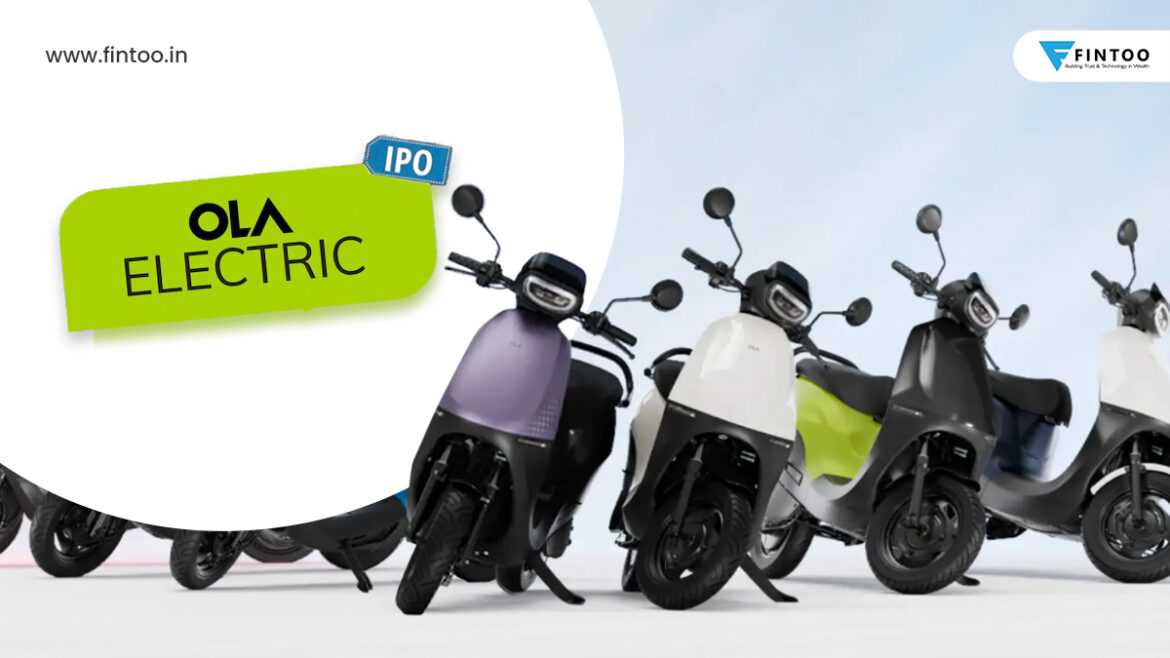

Highlights
| Issue Size –: 808,626,207 shares | Issue Open/Close – 02 Aug / 06 Aug, 2024 |
| Price Band (Rs.) 72 – 76 | Issue Size (Rs.) – 61,455 mn |
| Face Value (Rs) 10 | Lot Size (shares) 195 |
Ola Electric Mobility Limited (OLA) incorporated on 2017, is a pure EV player in India and are building vertically integrated technology and manufacturing capabilities for EVs and EV components, including cells. They manufacture EVs and certain core EV components like battery packs, motors and vehicle frames at the Ola Futurefactory.
In a very short span, they have delivered 7 products and additionally announced four new products since their first product announcement in August 2021. They commenced delivery of their first EV model, the Ola S1 Pro, in December 2021. This was followed by the delivery of the Ola S1 in September 2022, the Ola S1 Air in August 2023, the Ola S1 X+ in December 2023 and the Ola S1 X (2 kWh), the Ola S1 X (3 kWh) and the Ola S1 X (4 kWh) in May 2024.
OLA had the highest sales of all Indian incorporated electric 2Ws (E2Ws) original equipment manufacturers (OEMs) from E2W sales in Fiscal 2023. In FY22 OLA’s market in E2W was around 6 pct and in FY25 the market share of the company jumped to 35 pct.
Their business model is founded on 3 key scalable platforms: (1) Their R&D and technology platform with in-house design and development across EV technologies and components, (2) adaptable manufacturing and supply chain platform, and (3) D2C omnichannel distribution platform. Their model is vertically integrated across R&D and technology, manufacturing, supply chain, sales and service, and charging facilities.
OLA operate their own D2C omnichannel distribution network across India, comprising 870 experience centres and 431 service centres (of which 429 service centres are located within experience centres) as at FY24 in addition to their Ola Electric website.
Out of the total proceeds of Rs. 61,455 mn, Rs. 12,276 mn would go towards capex that to be incurred by their Subsidiary, OCT for the Project, Rs. 8,000 mn would go towards repayment or pre-payment, in full or part, of the indebtedness incurred by the subsidiary, OET, Rs. 16,000 mn would go towards research and product development, Rs. 3500 mn would go towards organic growth initiatives, Rs. 15,224 mn would utilize towards general corporate purpose and ~Rs. 6,455 mn would go towards existing selling shareholders of the company.
Key Highlights
- E2W penetration in India is expected to surge from ~5.4 pct of domestic 2W registrations in FY24 to ~41-56 pct of domestic 2W sales volume by FY28, while the Indian E2W industry is expected to grow at a CAGR of 11 pct to reach a size of USD 35 bn (~Rs. 2.8 trillion) to USD 45 bn (~Rs. 3.6 trillion) in FY28. Further, markets like Africa, LATAM and SE Asia provide a significant export opportunity for Indian E2W OEMs and OLA is well positioned to address this large market opportunity in EV.
- EVs have lower total cost of ownership (TCO) vs ICE vehicles, for e.g., electric two wheelers (that have led EV adoption in India) have ~55 pct lower TCO vs their ICE counterparts over the life of the vehicle. This is driven by lower fuel costs (roughly 1/10th of ICE) and other savings on vehicle spends (maintenance, registration subsidies). As cell cost fall the cost of EV will fall further.
- OLA has already grabbed major chunk of E2W industry by their existing scooter portfolio, now the company is announced a line-up of motorcycles comprising 4 models, (i) Diamondhead, (ii) Adventure, (iii) Roadster and (iv) Cruiser. They plan to commence delivery of the motorcycles in the H1FY26. Motorcycles will be the next focus segment for the company after scooters.
- At their Ola Futurefactory, they manufacture their EV scooters using certain EV components manufactured in-house and other components procured from third parties, such as cells. In addition, they operate a Battery Innovation Centre (BIC) in Bengaluru, India that is focused on developing cell and battery technology and manufacturing processes for their forthcoming cell manufacturing at the Ola Gigafactory.
- According to the report, OLA is the only EV manufacturer in India that is a beneficiary of two Government of India PLI schemes – one relating to the manufacture of advanced automotive technology products (the Automobile PLI Scheme) and another relating to advanced cell chemistry batteries (the Cell PLI Scheme). Under the Cell and Automotive PLI Schemes, all of the advanced chemistry cells and EVs that they manufacture and sell will qualify them for a cash incentive up until the specified cap under the schemes.
- Meanwhile, they have been awarded 20 GwH capacity under the Cell PLI Scheme. Under the Cell PLI Scheme, they are required to manufacture cells as per the committed capacity specified in bid. Accordingly, they are required to achieve 1 GwH capacity in the first year which they have achieved on FY2024, 5 GwH capacity in the 2nd year, 10 GwH capacity in the 3rd year and 20 GwH capacity by the 4th year.
- They have also developed the design of a 4680-form factor cell in-house at BIC, for which they have received BIS certification on May 13, 2024. They commenced manufacturing the 4680-form factor cells at their Ola Gigafactory on March 22, 2024. This cell is ~5x energy efficient than normal cell and the company is expecting to start commercial production of the cell in the next year.
- They undertake R&D activities in India, the UK and the US, focused on designing and developing new EV products and core EV components, such as battery packs, motors and vehicle frames. In last 3 years the company has spent Rs. 10.69 bn in R&D. Their R&D efforts are centred around 5 key technologies: (a) software, (b) electronics, (c) motor and drivetrain, (d) cells and battery packs and (e) manufacturing technology.
- OLA’s key strategy is to (i) Build India centric EV products with an India first strategy. (ii) Continue investment in R&D to advance their technological capabilities and optimize costs (iii) Building an EV hub with vertically integrated manufacturing and supply chain to improve cost efficiency. (iv) Develop their cell technology and strengthen in-house manufacturing capabilities. (v) Expand the product portfolio to drive market penetration (vi) Strengthen their D2C omnichannel network across sales, service and charging (vii) Allocate capital efficiently and focus on growth and (viii) Leverage the global EV opportunity.
- Sales of the company has grown by ~266.29 pct CAGR during the period FY22-24 and During FY24, company reported sales of Rs. 50,098 mn which grew by 90.42 pct YoY while EBITDA narrows from (Rs. 11,971 mn) to (Rs. 10,401 mn). As of FY24 the company reported loss of (Rs. 15,884 mn) which was grew from loss of (Rs. ~14,720 mn) pct YoY. Currently company importing Cell which adds cost to the company. Once OLA completes it cell production, this cost will reduce and will drive bottom line of the company.
Key Risk
- Any reduction or elimination of government incentives or the ineligibility of any of their electric vehicles for such incentives would increase the retail price of their electric vehicles and could adversely affect customer demand for the electric vehicles and affect OLA’s ability to achieve profitability.
- OLA could experience supply constraints, increased prices and quality issues in the supply of raw materials used in cell manufacturing, which could adversely affect cell manufacturing at their Ola Gigafactory and the quality of the cells produced therefrom.
- If OLA’s vehicles become ineligible for the EMPS 2024 subsidy they may become less competitive due to higher product pricing (without the subsidies), potentially impacting their business and financial performance.
Financial Performance
| Particulars | FY24 | FY23 | FY22 |
| Deliveries (in thousands) | 330 | 156 | 21 |
| Sales (in Rs. mn) | 50098 | 26309 | 3734 |
| Gross Margin (in Rs. mn) | 6303 | 605 | -1075 |
| Gross Margin (%) | 12.58% | 2.30% | -28.78% |
| Adjusted Gross Margin (in Rs. mn) | 8637 | 2123 | -246.4 |
| Adjusted Gross Margin (%) | 16.47% | 7.63% | -5.40% |
| EBITDA (in Rs. mn) | -10401 | -11971 | -7176 |
| EBITDA Margin | -19.84% | -43.02% | -157.27% |
| Profit/Loss (in Rs. mn) | -15884 | -14721 | -7842 |
| E2W Market Share | 34.80% | 21.00% | 5.70% |
Peer comparison based on FY24 Financials
| Particulars | OLA Electric | TVS Motors | Eicher Motors | Bajaj Auto | Hero MotoCorp |
| Deliveries (in thousands) | 330 | 4045 | 912 | 3728 | 5621 |
| Sales (in Rs. mn) | 50098 | 391447 | 165358 | 448704 | 377886 |
| Gross Margin (in Rs. mn) | 6303 | 147395 | 75551 | 129772 | 122792 |
| Gross Margin (%) | 12.58% | 37.65% | 45.69% | 28.92% | 32.49% |
| Adjusted Gross Margin (in Rs. mn) | 8637 | 148453 | 56310 | 144132 | 131337 |
| Adjusted Gross Margin (%) | 16.47% | 37.82% | 49.01% | 31.13% | 33.99% |
| EBITDA (in Rs. mn) | -10402 | 56058 | 58505 | 104652 | 60839 |
| EBITDA Margin | -19.84% | 14.28% | 33.22% | 22.60% | 15.74% |
| E2W Market Share | 34.80% | 19.30% | N/A | 3.90% | 0.10% |
Valuation
OLA is a pure-play EV company building towards a brighter, safer and greener future. They are building towards making India the world’s EV hub by creating an Ecosystem with products, services and technology which will define the next frontier of innovation. We were impressed by Ola’s cutting-edge technology and innovation. The passionate team leads the way in the innovation matrix. The company stands out in the Indian EV market with its nearly complete vertical integration, encompassing everything from cell manufacturing to sales and service. The promoters’ clear vision and commitment to futuristic products are commendable. OLA is yet to report profit at the EBITDA and the PAT level as it is still in the investment phase with substantial capex. At the upper end of the price band of Rs. 76 the issue is priced at a Mcap/Sales of ~6.39x its FY24 earnings. One can Subscribe from a longer-term perspective.
Also read: Evolving Landscape of Financial Advisory in India
Disclaimer: The views shared in blogs are based on personal opinions and do not endorse the company’s views. Investment is a subject matter of solicitation and one should consult a Financial Adviser before making any investment using the app. Investing using the app is the sole decision of the investor and the company or any of its communications cannot be held responsible for it.
Related Posts
Stay up-to-date with the latest information.


